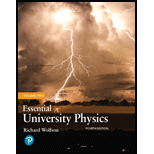
Essential University Physics
4th Edition
ISBN: 9780134988566
Author: Wolfson, Richard
Publisher: Pearson Education,
expand_more
expand_more
format_list_bulleted
Question
Chapter 34, Problem 40E
To determine
The minimum kinetic energy of the electron.
Expert Solution & Answer
Want to see the full answer?
Check out a sample textbook solution
Students have asked these similar questions
Hi! I need help with these calculations for part i and part k for a physics Diffraction Lab. We used a slit width 0.4 mm to measure our pattern.
Examine the data and % error values in Data Table 3 where the angular displacement of the simple pendulum decreased but the mass of the pendulum bob and the length of the pendulum remained constant. Describe whether or not your data shows that the period of the pendulum depends on the angular displacement of the pendulum bob, to within a reasonable percent error.
In addition to the anyalysis of the graph, show mathematically that the slope of that line is 2π/√g . Using the slope of your line calculate the value of g and compare it to 9.8.
Chapter 34 Solutions
Essential University Physics
Ch. 34.2 - Prob. 34.1GICh. 34.3 - If you replot Fig. 34.7 for a material with a...Ch. 34.3 - Prob. 34.3GICh. 34.4 - Prob. 34.4GICh. 34.5 - Prob. 34.5GICh. 34.6 - Prob. 34.6GICh. 34 - Prob. 1FTDCh. 34 - Prob. 2FTDCh. 34 - Prob. 3FTDCh. 34 - Prob. 4FTD
Ch. 34 - Prob. 5FTDCh. 34 - Prob. 6FTDCh. 34 - Prob. 7FTDCh. 34 - Prob. 8FTDCh. 34 - Prob. 9FTDCh. 34 - Prob. 10FTDCh. 34 - Prob. 11ECh. 34 - The surface temperature of the star Rigel is 104K....Ch. 34 - Prob. 13ECh. 34 - Prob. 14ECh. 34 - Prob. 15ECh. 34 - Prob. 16ECh. 34 - Prob. 17ECh. 34 - Prob. 18ECh. 34 - Prob. 19ECh. 34 - Prob. 20ECh. 34 - Prob. 21ECh. 34 - Prob. 22ECh. 34 - Prob. 23ECh. 34 - Prob. 24ECh. 34 - Prob. 25ECh. 34 - Prob. 26ECh. 34 - Prob. 27ECh. 34 - Prob. 28ECh. 34 - Prob. 29ECh. 34 - Prob. 30ECh. 34 - Prob. 31ECh. 34 - Prob. 32ECh. 34 - Prob. 33ECh. 34 - Prob. 34ECh. 34 - Prob. 35ECh. 34 - Prob. 36ECh. 34 - Prob. 37ECh. 34 - Prob. 38ECh. 34 - Prob. 39ECh. 34 - Prob. 40ECh. 34 - Prob. 41ECh. 34 - Prob. 42PCh. 34 - Prob. 43PCh. 34 - Prob. 44PCh. 34 - Prob. 45PCh. 34 - Prob. 46PCh. 34 - Prob. 47PCh. 34 - Prob. 48PCh. 34 - Prob. 49PCh. 34 - Prob. 50PCh. 34 - Prob. 51PCh. 34 - Prob. 52PCh. 34 - Prob. 53PCh. 34 - Prob. 54PCh. 34 - Prob. 55PCh. 34 - Prob. 56PCh. 34 - Prob. 57PCh. 34 - Prob. 58PCh. 34 - Prob. 59PCh. 34 - Prob. 60PCh. 34 - Prob. 61PCh. 34 - Prob. 62PCh. 34 - Prob. 63PCh. 34 - Prob. 64PCh. 34 - Prob. 65PCh. 34 - Prob. 66PCh. 34 - Prob. 67PCh. 34 - Prob. 68PCh. 34 - Prob. 69PCh. 34 - Prob. 70PCh. 34 - Prob. 71PCh. 34 - Prob. 72PCh. 34 - Prob. 73PCh. 34 - Prob. 74PCh. 34 - Prob. 75PCh. 34 - Prob. 76PCh. 34 - Prob. 77PCh. 34 - Prob. 78PCh. 34 - Prob. 79PCh. 34 - Prob. 80PCh. 34 - Prob. 81PCh. 34 - Prob. 82PPCh. 34 - Prob. 83PPCh. 34 - Prob. 84PPCh. 34 - Prob. 85PP
Knowledge Booster
Similar questions
- An object is placed 24.1 cm to the left of a diverging lens (f = -6.51 cm). A concave mirror (f= 14.8 cm) is placed 30.2 cm to the right of the lens to form an image of the first image formed by the lens. Find the final image distance, measured relative to the mirror. (b) Is the final image real or virtual? (c) Is the final image upright or inverted with respect to the original object?arrow_forwardConcept Simulation 26.4 provides the option of exploring the ray diagram that applies to this problem. The distance between an object and its image formed by a diverging lens is 5.90 cm. The focal length of the lens is -2.60 cm. Find (a) the image distance and (b) the object distance.arrow_forwardPls help ASAParrow_forward
arrow_back_ios
SEE MORE QUESTIONS
arrow_forward_ios
Recommended textbooks for you
 College PhysicsPhysicsISBN:9781305952300Author:Raymond A. Serway, Chris VuillePublisher:Cengage Learning
College PhysicsPhysicsISBN:9781305952300Author:Raymond A. Serway, Chris VuillePublisher:Cengage Learning University Physics (14th Edition)PhysicsISBN:9780133969290Author:Hugh D. Young, Roger A. FreedmanPublisher:PEARSON
University Physics (14th Edition)PhysicsISBN:9780133969290Author:Hugh D. Young, Roger A. FreedmanPublisher:PEARSON Introduction To Quantum MechanicsPhysicsISBN:9781107189638Author:Griffiths, David J., Schroeter, Darrell F.Publisher:Cambridge University Press
Introduction To Quantum MechanicsPhysicsISBN:9781107189638Author:Griffiths, David J., Schroeter, Darrell F.Publisher:Cambridge University Press Physics for Scientists and EngineersPhysicsISBN:9781337553278Author:Raymond A. Serway, John W. JewettPublisher:Cengage Learning
Physics for Scientists and EngineersPhysicsISBN:9781337553278Author:Raymond A. Serway, John W. JewettPublisher:Cengage Learning Lecture- Tutorials for Introductory AstronomyPhysicsISBN:9780321820464Author:Edward E. Prather, Tim P. Slater, Jeff P. Adams, Gina BrissendenPublisher:Addison-Wesley
Lecture- Tutorials for Introductory AstronomyPhysicsISBN:9780321820464Author:Edward E. Prather, Tim P. Slater, Jeff P. Adams, Gina BrissendenPublisher:Addison-Wesley College Physics: A Strategic Approach (4th Editio...PhysicsISBN:9780134609034Author:Randall D. Knight (Professor Emeritus), Brian Jones, Stuart FieldPublisher:PEARSON
College Physics: A Strategic Approach (4th Editio...PhysicsISBN:9780134609034Author:Randall D. Knight (Professor Emeritus), Brian Jones, Stuart FieldPublisher:PEARSON

College Physics
Physics
ISBN:9781305952300
Author:Raymond A. Serway, Chris Vuille
Publisher:Cengage Learning

University Physics (14th Edition)
Physics
ISBN:9780133969290
Author:Hugh D. Young, Roger A. Freedman
Publisher:PEARSON

Introduction To Quantum Mechanics
Physics
ISBN:9781107189638
Author:Griffiths, David J., Schroeter, Darrell F.
Publisher:Cambridge University Press

Physics for Scientists and Engineers
Physics
ISBN:9781337553278
Author:Raymond A. Serway, John W. Jewett
Publisher:Cengage Learning

Lecture- Tutorials for Introductory Astronomy
Physics
ISBN:9780321820464
Author:Edward E. Prather, Tim P. Slater, Jeff P. Adams, Gina Brissenden
Publisher:Addison-Wesley

College Physics: A Strategic Approach (4th Editio...
Physics
ISBN:9780134609034
Author:Randall D. Knight (Professor Emeritus), Brian Jones, Stuart Field
Publisher:PEARSON